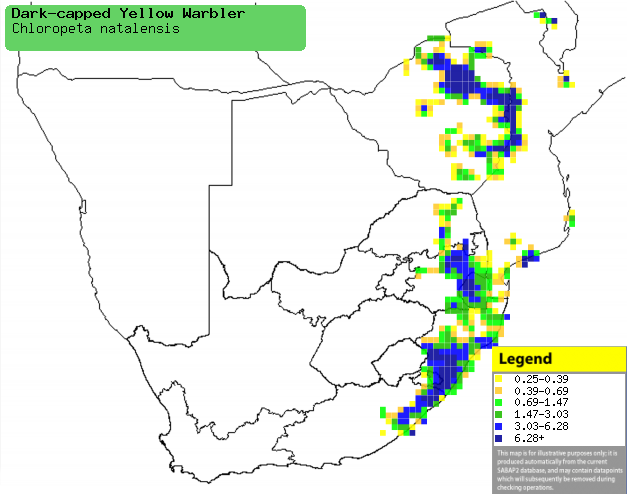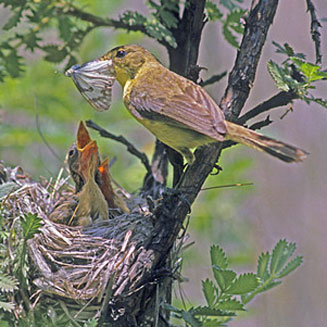|
Chloropeta natalensis
(Dark-capped yellow warbler, African yellow warbler)
Geelsanger [Afrikaans]; Gele rietzanger [Dutch];
Chloropète jaune [French]; Schnäpperrohrsänger [German];
Felosa-amarela-africana [Portuguese]
Life
> Eukaryotes >
Opisthokonta
> Metazoa (animals) >
Bilateria >
Deuterostomia > Chordata >
Craniata > Vertebrata (vertebrates) > Gnathostomata (jawed
vertebrates) > Teleostomi (teleost fish) > Osteichthyes (bony fish) > Class:
Sarcopterygii (lobe-finned
fish) > Stegocephalia (terrestrial
vertebrates) > Tetrapoda
(four-legged vertebrates) > Reptiliomorpha > Amniota >
Reptilia (reptiles) >
Romeriida > Diapsida > Archosauromorpha > Archosauria >
Dinosauria
(dinosaurs) > Saurischia > Theropoda (bipedal predatory dinosaurs) >
Coelurosauria > Maniraptora > Aves
(birds) > Order: Passeriformes
> Family: Sylviidae
For information about this species, see
http://www.birdforum.net/opus/African_Yellow_Warbler
Distribution and habitat
It occurs disjunctly from Nigeria east to Ethiopia, south
through eastern DRC, Angola and Zambia to southern Africa. Here it is locally
common in dense, moist vegetation along watercourses, also occurring along the
edge of reedbeds and forests.
|
 |
|
Distribution of Dark-capped yellow warbler in southern Africa,
based on statistical smoothing of the records from first SA Bird Atlas
Project (©
Animal Demography unit, University of
Cape Town; smoothing by Birgit Erni and Francesca Little). Colours range
from dark blue (most common) through to yellow (least common).
See here for the latest distribution
from the SABAP2. |
Food
It typically forages low down in the dense thicket that
characterises its preferred habitat, gleaning invertebrates such as
caterpillars from leaves and branches. It also hawks
termite alates, returning to a perch after catching them to feed on its
prey.
Breeding
- The nest (see images below) is a neat cup built with grass, typically
placed between upright stems or in the fork of bush, such as wild dagga (Leonotis)
and fireweeds (incl. Conyza and Epilobium).
 |
 |
| Dark-capped yellow warbler at its nest, South
Africa. [photo Johann Grobbelaar
©] |
Dark-capped yellow warbler at its nest with
chicks, Wakkerstroom, South Africa. [photo Warwick Tarboton ©] |
- Egg-laying season is from September-March.
- It lays 2-3 eggs, which are incubated mainly by the female for roughly
12 days.
- The chicks are fed by both parents but mainly the female, leaving the
nest after about 14-16 days, becoming independent about a month later.
Threats
Not threatened.
References
-
Hockey PAR, Dean WRJ and Ryan PG 2005. Roberts
- Birds of southern Africa, VIIth ed. The Trustees of the John Voelcker
Bird Book Fund, Cape Town.
-
Harrison, J.A., Allan, D.G., Underhill, L.G., Herremans, M.,
Tree. A.J., Parker, V. & Brown, C.J. (eds). 1997. The atlas of southern
African birds. Vol. 2: Passerines. BirdLife South Africa, Johannesburg.
|
